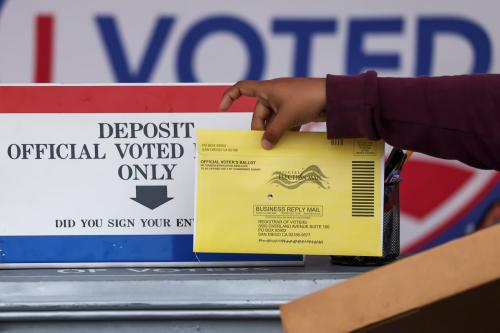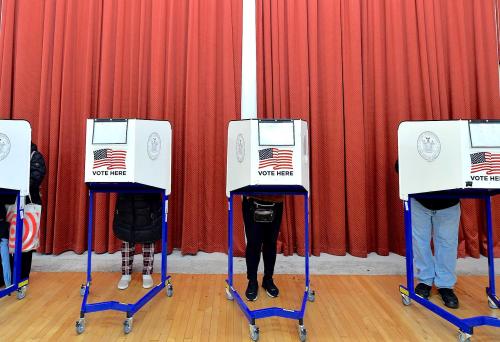The 2014 midterms have sparked a tremendous amount of interest, debate, and analysis around the question of whether Republicans will take control of the Senate, which issues have been relevant so far and what will resonate with voters when they head to the polls on Tuesday. Over the past two weeks, FixGov has offered analysis and observation that breaks down the Midterms across a variety of policy areas and focused on specific Senate races.
The 2014 election has been called both ‘the election about nothing’ (and therefore everything) and the ‘chaos election’. It’s of little surprise then that no single issue has emerged to define and unify the campaigns. A whole host of issues have proven relevant and are playing out differently across the country. The nearly two dozen posts in the series reflect the multiplicity of important issues; from a debate about the role of energy policy on the campaign trail and in the future Congress, to a discussion of how foreign policy problems like ISIS and the Russia/Ukraine crisis have influence rhetoric.
Without a far broader base of political support than it has found in the 2014 campaign, the Clean Power Plan’s future looks awfully uncertain. –Phil Wallach
Belle Sawhill and Richard Reeves talk about how economic issues surrounding the women’s vote and inequality have been a focal point of some campaigns. Marisa Abrajano and Taeku Lee examine voting patterns and turnout efforts among specific demographic groups. As Sawhill explains,
“…women’s issues aren’t limited to abortion and contraception and Republican candidates appear to be banking on Democrats only campaigning for women’s votes by talking about reproductive rights. Indeed, women as a group care even more about economic issues…”
The Iowa race is currently such a toss-up that the direction of a potential gender gap could decide it. –Tracy Osborn
The series also features posts about campaign finance, marijuana legalization and Affordable Care Act, highlighting some of the more contentious issues of the day. However, not every issue played similarly in each state, making the elections increasingly unpredictable. As Stephen Voss explained in his blog post about the Kentucky Senate race,
“The same state that elected Tea Party poster child Rand Paul to the U.S. Senate in 2010 turned around in 2011 and overwhelmingly reelected Democratic Gov. Steve Beshear, who was liberal enough to establish a Kentucky version of the Obamacare insurance exchanges without waiting for legislative support.”
The series invited a group of nine experts from states with competitive Senate races to give us an overview of those campaigns. Each expert answered a series of six questions about issues, campaign finance, media coverage and more. These expert insights revealed some key differences between the competitive Senate races that have been the focus of so much national attention. For example, since no incumbent is seeking re-election in the Georgia Senate race, the candidates’ individual personalities have played an outsized role relative to policy issues. Additionally, as Carson explains, the fact that both the governor’s race and the Senate race look competitive may increase turnout even more.
Georgia is featuring a gubernatorial race between Republican incumbent Nathan Deal and Democratic challenger Jason Carter, grandson of former President Jimmy Carter. The presence of that race on the ballot may increase turnout beyond what we might normally see in a midterm election. – Jamie Carson
You can read state-level analysis about:
- Arkansas from Jay Barth (Hendrix College)
- South Dakota from Jon D. Schaff (Northern State University)
- Kansas from Patrick Miller (University of Kansas)
- North Carolina from Jason Husser (Elon University)
- Louisiana from Michael Henderson (LSU)
- Georgia from Jamie Carson (University of Georgia)
- Alaska from Jerry McBeath (University of Alaska-Fairbanks)
- Iowa from Tracy Osborn (University of Iowa)
- Kentucky from Stephen Voss (University of Kentucky)
While the outcome of the midterm elections are still unknown, the issues that have been front and center will most certainly shape the next two years of Congress, and President Obama’s final years office. On Election Day, frustrated voters will head to the polls and determine what the remainder of the Obama presidency will look like. How the register their frustration is yet to be seen.
“Government provides security, not only by protecting against physical danger, but also by providing reassurance that it is competent and confident about our collective ability to master the challenges we confront. By that standard, today’s elected officials have failed miserably.” – Bill Galston
Next week, FixGov will offer analysis and commentary about the results of Tuesday’s midterms and talk extensively about what to expect moving forward into the 114th Congress and the 2016 elections.
The Brookings Institution is committed to quality, independence, and impact.
We are supported by a diverse array of funders. In line with our values and policies, each Brookings publication represents the sole views of its author(s).




Commentary
Understanding the 2014 Midterm Elections
October 31, 2014